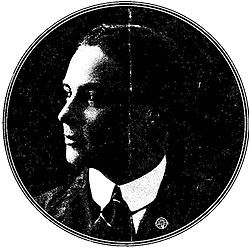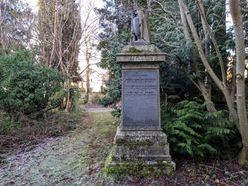George Pattullo

Here was a man who arrived in Spain, in Catalonia, in Barcelona as a tennis-playing coal-merchant and left a year later a footballing hero with a goal-scoring record for the club that bears the city's name that is second to just two; and one of them is Lionel Messi.
The story is that Jorge Patullo, George Pattullo and not John Patullo as he is sometimes called, George Simpson Drynan Pattullo was discovered by Hans (Joan) Gamper, the founder of Barcelona Football Club, playing as a ringer. He had been drafted in to make up the numbers for the former in a match between a British eleven and a University team. As such he was stuck in goal, had five put past him by half-time, played the second half up front and scored five in what ended a 6-5 victory. The University wanted a rematch. It ended 4-4 , Pattullo scoring all his side's and a watching Gamper more than impressed.
Such is the stuff of football legend. The year was 1910 and it may have been that Pattullo had arrived in Catalonia from Newcastle. Certainly he was back there in 1914, joining the Tyneside Scottish Brigade for the Great War, being awarded the Military Cross and also being badly gassed. And he still there for much of the next decade and a half, on the face of it curiously from 1918 to 1920 living with a Georgina Pattullo, then alone for a year and for six more years until 1927 with an Agnes Pattullo. But he had been born in November 1888 in Glasgow right in Crosshill, the son of a prosperous Oil Merchant, who had died eight months earlier in April. And grew up there almost within sight of Queen's Park and Hampden at a time when the Scottish game was at its second peak. In 1891 and 1901 he and his elder sister, Jean, the Newcastle Georgina, who married there in 1920, were staying either side of Maxwell Park with their maternal grandmother, Agnes, living on private means with their mother, again Agnes; which also suggests she might have been the one to have been with him again in Newcastle two decades later.
Thus it was that under Gamper's initial wing the man described as the club's "most important and influential Brit of all time" and therefore ranking him above Gary Lineker, Steve Archibald and Mark Hughes made his first appearance for Barcelona in September of the year of his arrival. He would play twenty-four matches for the club, twenty-three that season, and score forty-three times, forty-one in those twenty-three, and by the time the business that had brought from Britain meant he had to return there again it would win the 1910-11 Catalonian Championship.
And that would have seemed to be it. But he did return for one last game and flourish and two final shows. Firstly, Barcelona had reached the semi-final of the 1912, cross-border Pyrenean Cup. The game was against city rivals, Espanyol, and not only was he just able to make it but to score twice more in a 3-2 victory. It prompted the losing club to make Pattullo an offer to turn professional but he not only declined, ever the amateur, but also seemed to have left playing football, if not football itself, entirely behind. Secondly, in 1928 he returned to the Catalan capital and the then stadium, Camp de les Corts, taking the honorary kick-off of a Spanish Championship game between Barca and Oviedo, this in the year before the foundation of La Liga. The date was the 15th April, Barcelona would win 7-3, Samitier, Pattullo-like, scoring five and it was probably no more than pleasant break for the Scot en-route to Majorca. The gassing of two decades earlier had taken a toll on his health and the warmth and dry the Balearics was thought might be helpful. It probably was at least initially allowing him to dip a toe once more in the game. The move to the island allowed him in 1930 to manage, albeit briefly, Palma's Club Baleares.
It was also on Majorca that Pattullo is said to have married, although the marriage does not seem to have lasted. He was soon to have returned to the the UK, probably hastened by the outbreak in 1936 of the Spanish Civil War but it was neither to Scotland or even Newcastle but to London. In the meantime both his sister and his mother seemed to have moved south and he looks to have followed.
In London he seems to have settled specifically in the Notting Hill Gate area. In 1947, so in his late fifties, he was living in Lancaster Gate, with few other details except there might have been decline. perhaps even alcohol problems. Certainly he would die aged sixty-four in September 1953 with his address given as not far from that of 1947 but in then far less salubrious North Paddington.
However, that is not quite the end of the story. The death itself was registered not in North London but in Putney cum Wandsworth. The reason was probably that his ninety year-old mother would survive him by a year and, as she had been a decade earlier, was living there albeit she would die in Lancing in Sussex. But even there there is an explanation. Her daughter and George's sister was nearby. Her death in 1964 would be in Worthing.
However, there still remains one last quandary - George Simpson Pattullo's burial-place. In spite of his death down South it was thought that it had been in Cathcart Cemetery, Glasgow, just a short distance from his childhood homes. But the substantial plinth there is thought now to be a memorial- not a grave-stone, with as a final twist its erector and therefore Pattullo-honourer for now still unknown.

Birth Locator:
103, Albert Road, Pollokshields East, Glasgow
Residence Locator(s):
1891 - 63, Shields Road, Glasgow
1901 - 10, Matilda Rd., Kinning Park Glasgow
1918 - 1927 - 32, Sanderson Rd., Jesmond, Newcastle-upon-Tyne
1947 - 44-46, Inverness Terrace, Lancaster Gate, London
1953 - 66, Westbourne Park Rd., Paddington, London
Grave/Memorial Locator:
Ground Locator:
and
Other Sources:
Back to the Spanish Trail,
or the SFHG Home page